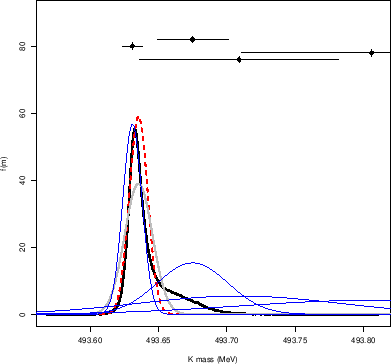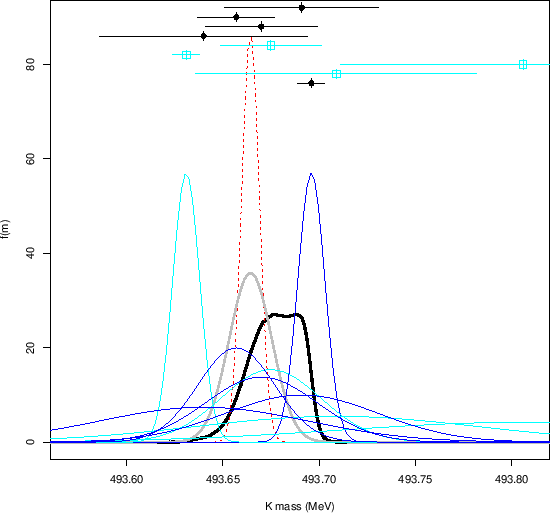Next: Correlations among the values Up: Further scepticism Previous: Sceptical analysis using the
|
 |
It is then interesting to make a sceptical combination of these
four points. The result is shown if Fig. 14.
The sceptical analysis takes into account also the results favoring
higher mass values, although the peak of the distribution (the `mode')
remains very close to the most precise result,
and there is a substantial overlap with it.
The distribution is now skewed on the right side, assigning
higher probability that the mass value is, for example, above
![]() MeV
with respect to what we could think judging from
mean and standard deviation alone. The resulting mass is
MeV
with respect to what we could think judging from
mean and standard deviation alone. The resulting mass is
![]() MeV shifted up by about
MeV shifted up by about ![]() keV, with a standard
uncertainty about 50% larger than that provided
by the
keV, with a standard
uncertainty about 50% larger than that provided
by the
![]() scaling prescription.
But what is more interesting is that the latter
(gray line in the figure,
just below the red dashed one) does not give a correct account of the
possible values of
scaling prescription.
But what is more interesting is that the latter
(gray line in the figure,
just below the red dashed one) does not give a correct account of the
possible values of ![]() , because: i) it is extended to the
low mass values sizable more than the measured points would allow it;
ii) it gives practically no chance to mass values above e.g.
, because: i) it is extended to the
low mass values sizable more than the measured points would allow it;
ii) it gives practically no chance to mass values above e.g.
![]() MeV.
MeV.
Finally there is the question of combining this result with the other five ones of other experiments. What should we use as input for the global analysis? Honestly, at this point we cannot pretend to have not seen the outcome shown in Fig. 14 and to use just the resulting average and standard uncertainty. We also cannot feed into the model the complicated posterior we have got. Therefore the only solution is to make a new combined analysis, but using all individual results of Ref. [8]. For sake of clarity all points are repeated in Tab. 2.
 |
“The same as the PDG result”, one would promptly shout at this point,
“and after so much work!”. Well, yes and no...
Indeed, the PDG numbers
were obtained considering an arbitrarily enlarged
uncertainty for the combined result of Ref. [8].
Applying, instead, the scaling prescription to
the nine individual points of Tab. 2
a value of
![]() MeV would have been obtained,
MeV would have been obtained,
![]() keV below the result of the sceptical analysis
(see Fig.15).
Certainly this
keV below the result of the sceptical analysis
(see Fig.15).
Certainly this
![]() bias will not harm
our understating of fundamental physics, but it is better
to avoid this kind of biases because they could
perhaps be important in other measurements.
bias will not harm
our understating of fundamental physics, but it is better
to avoid this kind of biases because they could
perhaps be important in other measurements.